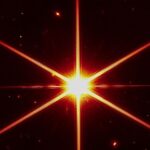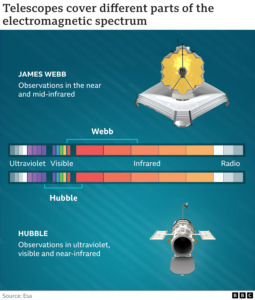 The James Webb Space Telescope (JWST) is working as engineers hoped, but NASA says “a lot of work still lies ahead” to put it in operation, BBC News reported on Wednesday, March 16, 2022 (see story here).
The James Webb Space Telescope (JWST) is working as engineers hoped, but NASA says “a lot of work still lies ahead” to put it in operation, BBC News reported on Wednesday, March 16, 2022 (see story here).
The photo at left is an alignment image on a test star used to calibrate the telescope’s mirrors. The galaxies visible behind it are billions of light years away.
Everything we know about the universe comes from light, radio waves, and particles captured first by the human eye and later by increasingly sophisticated instruments.
Early humans could observe only light visible to the naked eye; the first telescopes, made in the early 17th century, magnified this light but didn’t expand the range of what could be observed; and even as telescopes improved, astronomical observations were limited to visible light until the late 19th century.
The 20th century’s technology dramatically changed how those basic components of astronomical data are captured and processed. Capturing light on photographic plates replaced looking through telescopes, radio telescopes captured a whole new range of data, and space telescopes began providing images free of atmospheric distortion.
As the graphic below shows, the JWST is designed to capture a different light spectrum than the Hubble Space Telescope (HST), mostly in the infrared spectrum invisible to the human eye. The idea behind this is to see fainter and more distant objects (details here), providing astronomers with, among other things, new insights into the oldest stars and early formation of the universe.
